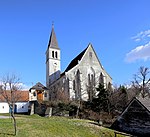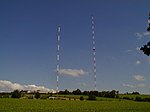Korneuburg

Korneuburg (German pronunciation: [kɔʁˈnɔʏbʊʁk] ; Central Bavarian: Korneibuag) is a town in Austria. It is located in the state Lower Austria and is the administrative center of the district of Korneuburg. Korneuburg is situated on the left bank of the Danube, opposite the city of Klosterneuburg, and is 12 km northwest of Vienna. It covers an area of 9.71 square km and, as of 2001, there were 11,032 inhabitants. Korneuburg was originally a bank settlement associated with Klosterneuburg under the name Nivenburg. It was first mentioned in 1136, and in 1298 received the right to formal separation from Klosterneuburg. In 1938, the shipyard Korneuburg was integrated into the Hermann-Göring-Werke, and significantly enlarged. In 1941, 16 barracks for Germans, forced laborers and prisoners of war were added. In 1945, the Red Army captured the shipyard.Military campaigns involving the city include the Battle of Vienna, the Thirty Years' War, the French Revolutionary Wars, and the Oil Campaign of World War II. The Korneuburg Shipyard is now the site of a branch of the Museum of Military History, Vienna comprising two patrol boats, Niederösterreich and Oberst Brecht. These were the Austrian Army's last patrol ships on the Danube, and the successors of the KuK Kriegsmarine.
Excerpt from the Wikipedia article Korneuburg (License: CC BY-SA 3.0, Authors, Images).Korneuburg
Lebzeltergasse, Gemeinde Korneuburg
Geographical coordinates (GPS) Address Nearby Places Show on map
Geographical coordinates (GPS)
| Latitude | Longitude |
|---|---|
| N 48.345277777778 ° | E 16.333055555556 ° |
Address
Lebzeltergasse 6
2100 Gemeinde Korneuburg
Lower Austria, Austria
Open on Google Maps











